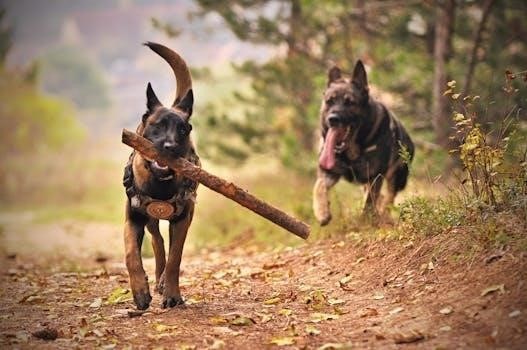Many common human foods are surprisingly dangerous, and even deadly, for dogs. Understanding which foods are toxic is crucial for responsible pet ownership. This guide helps prevent accidental exposure to these harmful substances.
Why a Printable Guide is Essential
A printable guide to toxic foods for dogs is an invaluable tool for any pet owner. With so many everyday items posing a threat, having a readily available list in your kitchen can be a lifesaver. This quick reference eliminates the need to search for information during a stressful situation, ensuring that you can act quickly and confidently. It serves as a constant reminder of the potential dangers lurking in your pantry, helping to prevent accidental ingestion; By displaying this guide, you can also educate family and friends, promoting a safe environment for your beloved canine companion. This easy-to-use resource provides peace of mind, knowing that you are equipped to protect your dog’s health.

Common Toxic Foods for Dogs
Several everyday foods pose significant risks to dogs. These include chocolate, grapes, onions, garlic, xylitol, and macadamia nuts, all capable of causing serious health issues.
Chocolate and Methylxanthines
Chocolate is a well-known danger to dogs due to the presence of methylxanthines, specifically theobromine and caffeine. These substances can cause various problems, including vomiting, diarrhea, hyperactivity, increased heart rate, tremors, seizures, and in severe cases, even death. The darker the chocolate, the higher the concentration of these toxic compounds, making dark chocolate and baking chocolate particularly dangerous. Different types of chocolate contain various levels of fat, caffeine and the substances methylxanthines. It’s essential to keep all chocolate products well out of reach of your canine companions to avoid accidental ingestion and potential poisoning.
Grapes and Raisins⁚ Kidney Failure Risk
Grapes and raisins, even in small quantities, pose a significant risk of kidney failure in dogs. The exact toxic substance is unknown, but their ingestion can lead to acute kidney injury, which can be fatal if not treated promptly. Symptoms may include vomiting, lethargy, decreased appetite, and abdominal pain. It is crucial to seek immediate veterinary care if you suspect your dog has consumed grapes or raisins, as hospitalization and fluid therapy may be necessary to support the kidneys and help prevent severe complications. Even one grape or raisin can be dangerous for dogs, making it imperative to keep these fruits out of reach.
Onions, Garlic, and Chives⁚ Red Blood Cell Damage
The onion family, including onions, garlic, and chives, poses a serious threat to dogs, whether consumed raw, cooked, dried, or powdered. These foods contain compounds that can damage red blood cells, leading to anemia. Symptoms may not be immediate and can appear several days after ingestion, including weakness, lethargy, pale gums, and decreased appetite. The severity of the reaction depends on the amount consumed and the dog’s size. Both dogs and cats are susceptible, though dogs are more commonly affected. It is crucial to avoid feeding your dog any food containing these ingredients and to store them safely out of reach. Immediate vet care is recommended if consumption is suspected.
Xylitol⁚ Sugar Substitute Danger
Xylitol, a common artificial sweetener found in many sugar-free products like candies, gums, baked goods, and some diet foods, poses a significant danger to dogs. Even small amounts of xylitol can cause a rapid and drastic drop in a dog’s blood sugar levels, leading to hypoglycemia. This can result in symptoms such as vomiting, lethargy, loss of coordination, and seizures. In severe cases, xylitol poisoning can lead to liver failure, which can be fatal. It’s crucial to keep all products containing xylitol completely out of reach of dogs and seek immediate veterinary attention if your dog has ingested any amount of this toxic substance. Early intervention can greatly improve the chances of a full recovery.
Macadamia Nuts⁚ Toxicity Concerns
Macadamia nuts, while delicious to humans, are another food that should be strictly avoided when it comes to dogs. The exact toxic mechanism is not fully understood, but even a small amount of macadamia nuts can cause a range of symptoms in dogs. These symptoms can include weakness, vomiting, tremors, lethargy, and an elevated body temperature. While not typically fatal, macadamia nut toxicity can still be quite distressing for your dog and will require veterinary care. It is best to err on the side of caution and ensure that these nuts are never given to your dog or left within their reach. Keep all nuts stored safely and out of the reach of your canine companion.

Other Dangerous Foods
Beyond the common culprits, several other foods pose significant risks to dogs. These include items like avocado and alcohol, which can cause severe health problems and should be strictly avoided.
Avocado and Persin
Avocado contains a toxin called persin, which can be harmful to dogs. While not always fatal, persin can cause vomiting, diarrhea, and general gastrointestinal upset. The highest concentration of persin is found in the leaves, seed, bark, and skin of the avocado, but the fruit pulp also contains some. It’s important to keep all parts of the avocado plant out of your dog’s reach. Symptoms of avocado poisoning can vary in severity, but it is best to avoid feeding avocado to your dog entirely. Persin is also toxic to other animals as well. Always err on the side of caution.
Alcohol⁚ Coma and Death
Alcohol is extremely dangerous for dogs, even in small amounts. Ingestion can rapidly lead to severe health issues, including coma and death. Dogs metabolize alcohol differently than humans, making them much more susceptible to its toxic effects. Symptoms can include vomiting, disorientation, difficulty breathing, and seizures. Alcohol depresses the central nervous system, leading to a dangerous drop in body temperature and blood sugar. Alcoholic beverages, as well as foods containing alcohol, should always be kept well out of your dog’s reach. Immediate veterinary care is essential if alcohol ingestion is suspected.

Foods to Avoid
Beyond common toxins, some foods pose risks. These include moldy items, candies, and sweeteners like xylitol. Awareness of these less obvious dangers is vital for dog safety.
Mouldy Foods and Mycotoxins
Mouldy foods are a significant danger to dogs due to the presence of mycotoxins. These toxic substances are produced by certain types of fungi and can cause serious health issues. Commonly affected foods include dairy products, walnuts, peanuts, and grain-based items like pasta and bread. Access to compost bins should also be restricted, as they often contain mouldy food waste. Mycotoxins can lead to a range of symptoms, from gastrointestinal upset to more severe neurological problems. Always ensure that food is stored properly and any signs of mold are discarded. Promptly consult a veterinarian if you suspect your dog has consumed mouldy food.
Candy and Sweeteners
Candy and many sweeteners pose a significant risk to dogs, primarily due to the presence of xylitol. Xylitol is an artificial sweetener found in many sugar-free products, including candies, gum, baked goods, and even some toothpaste. Ingestion of xylitol can cause a rapid and dangerous drop in blood sugar levels in dogs. This can lead to symptoms such as vomiting, lethargy, and coordination problems. In severe cases, xylitol poisoning can result in seizures and liver failure, which can be fatal. It is crucial to keep all products containing xylitol out of reach of your dog and to read labels carefully. Chocolate is also very dangerous.

Importance of Immediate Veterinary Care
If you suspect your dog has ingested a toxic substance, contact your veterinarian immediately. Prompt veterinary care can significantly improve outcomes and potentially save your dog’s life.
What to Do if Your Dog Eats Something Toxic
If your dog has eaten a potentially toxic food, immediate action is crucial. First, try to identify what and how much they consumed. Contact your veterinarian or a pet poison helpline right away. Do not induce vomiting unless specifically instructed by a professional, as this can sometimes worsen the situation. Be prepared to provide details about your dog’s breed, age, and any symptoms. Follow the vet’s instructions carefully. Depending on the substance and amount ingested, they may advise you to bring your dog in for treatment. Early intervention is key to a better outcome.
